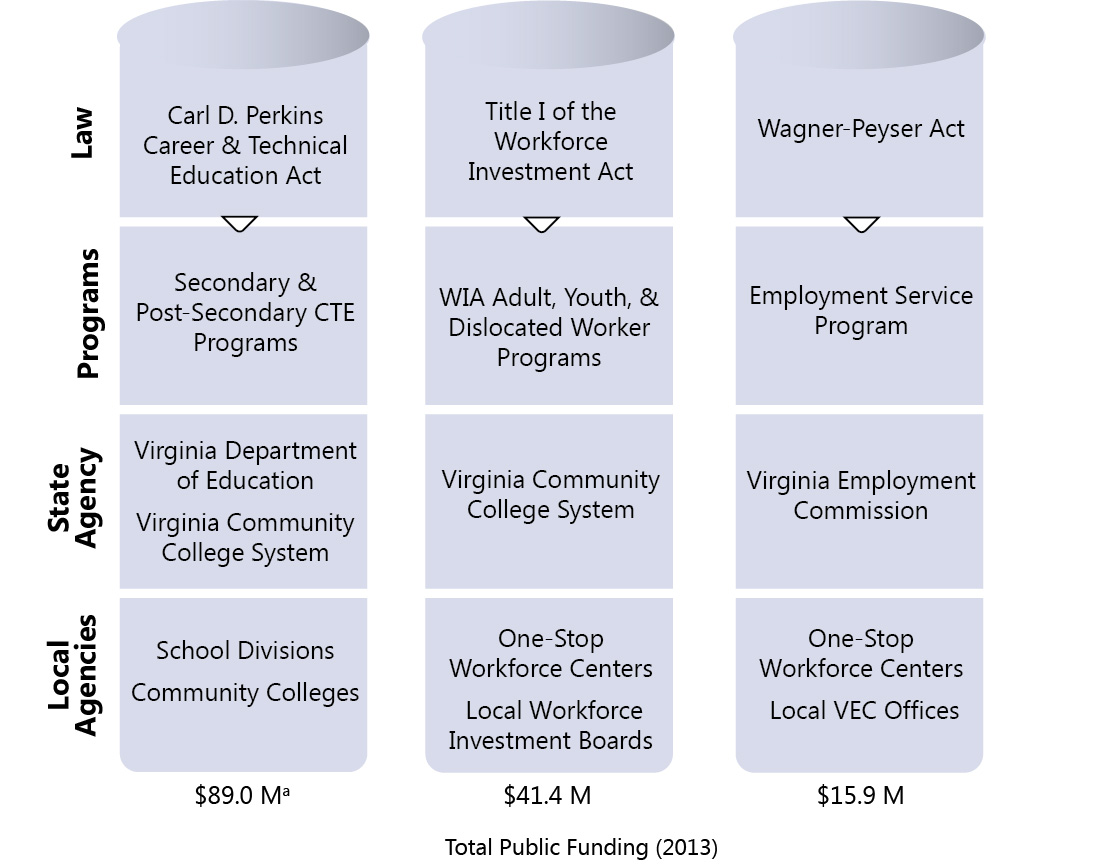Virginia’s Workforce Development Programs
Awarded the 2015 NLPES Certificate of Impact

Why we did this study
The General Assembly directed JLARC to assess how effectively Virginia’s workforce development programs meet the needs of employers and to examine the transparency of information on program expenditures and outcomes. Interest in this topic was prompted by perceptions that state and local workforce development efforts are not adequately coordinated and do not provide sufficient opportunities for job seekers to obtain the skills, credentials, and education desired by employers.
About Virginia's Workforce Development Programs
Workforce development programs are instrumental in supporting resilient regional and state economies and producing a high quality workforce valued by employers. In fiscal year 2013, Virginia’s workforce development programs received $341 million in state, federal, and local funding. Programs are intended to provide services that help individuals enter and advance in the workplace, through job placement assistance, training and education, and assist employers with recruitment and training. Federal laws govern most workforce programs, which are administered by nine state agencies and overseen by the Virginia Board of Workforce Development. Services are provided locally by a variety of agencies.
What we found
Employers have difficulty filling job openings and navigating workforce development programs.
Workforce development programs do not appear to meet the expectations of many employers with respect to producing the workforce they need and providing services they value. Employers report difficulty filling job openings, including finding applicants who possess relevant work experience and job-specific skills as well as the basic skills needed to succeed in the workplace.
Many employers expressed frustration with navigating workforce development programs, which they described as complex and disjointed. Workforce development programs have tools and resources to address employers’ workforce needs, including assistance with recruiting qualified applicants and customized training. However, only 16 percent of employers surveyed for this study sought the assistance of a public workforce development provider when they experienced difficulty filling a position.
Some programs for teaching in-demand skills do not reflect state labor market
Career and technical education (CTE) programs in high schools and community colleges do not always direct their resources toward courses that are related to occupations with the greatest employment potential. Misalignment between course offerings and job openings may be contributing to employers’ difficulty finding qualified applicants. High school CTE programs across the state appear to prioritize courses in the science, technology, engineering, and math (STEM) and business fields, which offer a large number of current and future employment opportunities. In contrast, only three percent of high school CTE courses are in the health sciences, even though this field represented nearly 20 percent of all job openings in 2013. While underemphasizing health sciences, school divisions appear to overemphasize programs that provide less marketable skills, such as arts and communications and human services programs.
Community colleges appear to offer CTE courses for in-demand skills and credentials, but there are opportunities for colleges to more effectively shape their programs to match employers’ needs. In particular, community colleges are not providing courses in subjects that would meet local employers’ needs in certain regions of the state. A comparison of the individual courses offered at community colleges and occupations with open positions in the surrounding area identifies several regions where jobs are available, but there is no related instruction nearby.
CTE courses may not be consistently aligned with labor demand because high schools and community colleges do not effectively incorporate employer input and labor market data into the design of education and training programs. High schools and community colleges use advisory committees to gain input from employers, but the quality of their contributions varies greatly. Advisory committees do not meet regularly in all regions and are not always composed of employers. In addition, school divisions do not effectively use labor market information and employer input when determining which CTE courses to offer. The Virginia Department of Education requires school divisions to submit labor market information when seeking approval for a new CTE course, but the information submitted is too general to ensure that the department’s approval of courses is predicated upon a labor market need.
Programs aimed at developing work experience are not fully utilized
Several workforce development programs exist for students and job seekers to gain work experience, but they are underutilized and, in some cases, have not been effectively marketed. As a result, workers in Virginia may miss opportunities to develop the work experience that current job applicants lack, according to employers. For example, the programs funded by the federal Workforce Investment Act (WIA) spent less than one percent of their funding to provide on-the-job training opportunities.
Virginia’s registered apprenticeship program appears more limited than programs in other states, which market their services to job seekers and employers and help promote apprenticeship opportunities. Although federal funds could be used to defray the cost of the program to employers, this practice is currently not in place in Virginia. The apprenticeship program is administered by the state Department of Labor and Industry, whose focus is not on workforce, and the classroom portion of the program is overseen by the Virginia Community College System.
Employer engagement efforts are uneven across regions
Although workforce development programs have increased efforts to engage employers through surveys, meetings, and conferences, these efforts are largely ad hoc and inconsistent across the state. Certain regions and certain programs have developed services without sufficient employer input. According to employers, such services are difficult to navigate or simply not useful, reinforcing their negative perceptions of the local workforce development system.
Lack of coordination and inconsistent participation by key local agencies undermines quality of workforce development efforts
The quality and effectiveness of workforce development programs can vary appreciably across Virginia’s regions because local agencies have substantial discretion in their implementation of programs and services. Local agencies do not use consistent and effective approaches for coordinating their workforce development efforts, and in some cases, key workforce development entities are not sufficiently included. Effective coordination strategies have been developed in some regions, and these strategies may serve as examples for programs in other regions. At present, though, most of the regions examined for this study have not established a forum that brings together all key stakeholders for the purpose of coordinating workforce development services and collaborating on regional workforce development strategies.
Local workforce development agencies have varying notions of their roles in workforce development and in regional partnerships. Agencies tend to focus on their own core missions, and some key agencies have been inconsistent and unreliable partners in local workforce development efforts. Staff of programs in several regions reported, in particular, a lack of cooperation by the Virginia Employment Commission (VEC), especially with regard to contributing staff resources to one-stop workforce centers. Eight of the 23 one-stop centers have little or no staff representation from the local VEC office. Workforce investment board directors and other staff interviewed for this study expressed concern that customers who go to a VEC office instead of a one-stop center may not learn about or be referred to other local workforce services, such as skills training or education.
In addition, despite the importance of CTE programs in workforce development, CTE program administrators reported varying levels of school division participation in and awareness of regional workforce development efforts. Further, workforce development programs do not consistently involve economic development agencies in workforce development efforts, despite their stated objective to assist employers with workforce needs.
Board of Workforce Development is not equipped to establish a system of workforce development programs
Strong state-level governance and oversight are needed to achieve the state’s vision for a coordinated and efficient system of workforce development programs and agencies, given the fragmentation of the service delivery system at the local level. Currently, the Virginia Board of Workforce Development does not have sufficient statutory authority over the state agencies that administer workforce development programs to create a workforce development system in which all relevant agencies and programs operate according to a shared mission and priorities. Further, the board does not appear to have sufficient representation from key state agencies and local entities or sufficient capacity to carry out all of its responsibilities.
Decentralized nature of major workforce development programs underscores importance of coordination

Source: JLARC staff analysis of federal laws; Mapping the Virginia Workforce System: A Status Report on Workforce Programs in the Commonwealth, Virginia Commonwealth University (2013); Workforce Development in Virginia, The Commonwealth Institute (2013); and state agency websites.
aIncludes federal Perkins funds and state general funds. Of the federal Perkins funds that are distributed locally, 85 percent are allocated to school divisions and 15 percent are allocated to community colleges.
Lack of uniform spending classification hinders meaningful spending review
Spending definitions and calculations are not standardized within and across programs. As a result, state-level oversight entities, such as the Board of Workforce Development, lack reliable spending data with which to evaluate whether key activities, such as training and education, are funded appropriately. Under the current system, it is difficult to compare the spending patterns of workforce development programs because of variation in how programs categorize their expenditures. For example, one program might define basic employment workshops as “training” while another program might classify them as “employment assistance.” Definitions also vary within a single program, such that costs for the same program are categorized and calculated differently from one locality to another.
Current performance measures do not provide comprehensive assessment of program performance
Many of Virginia’s workforce development programs are evaluated against performance measures and goals assigned to them by the state and federal governments. However, performance measures do not reflect state workforce development priorities, such as employer satisfaction with the workforce or the programs, and the measures vary by program, which prevents a performance assessment of the workforce development system as a whole. Moreover, for some programs, performance measures or goals have not been developed at all. The Board of Workforce Development is currently working to establish additional, more standardized measures that would better reflect the state’s workforce priorities.
What we recommend
Legislative action
- Require the Board of Workforce Development to annually evaluate the extent to which workforce development programs emphasize training and education opportunities that align with the needs of employers.
- Enhance the authority of the Board of Workforce Development to influence the workforce development policies of state agencies.
- Create a formal advisory council to the Board of Workforce Development, composed of key state and local entities not currently represented.
- Require state agencies to develop standard categories of program spending that can be reported to the Board of Workforce Development.
- Require the Board of Workforce Development to establish standard performance measures for all workforce development programs and ensure that all measures support the state’s highest workforce development priorities.
Executive action
- Require school divisions and community colleges to include employers on CTE advisory committees and to meet at least every six months.
- Require community colleges to adopt a common curriculum development process that fully incorporates employer input.
- Develop criteria to measure whether new CTE courses proposed by school divisions are aligned with labor market demand.
- Require school divisions’ CTE advisory committees to annually develop recommendations to improve the relevancy of CTE program offerings.
- Designate a single entity in each workforce region to lead workforce development efforts, including the development of a local plan for employer engagement and the formation of a formal region-wide workforce development council.

